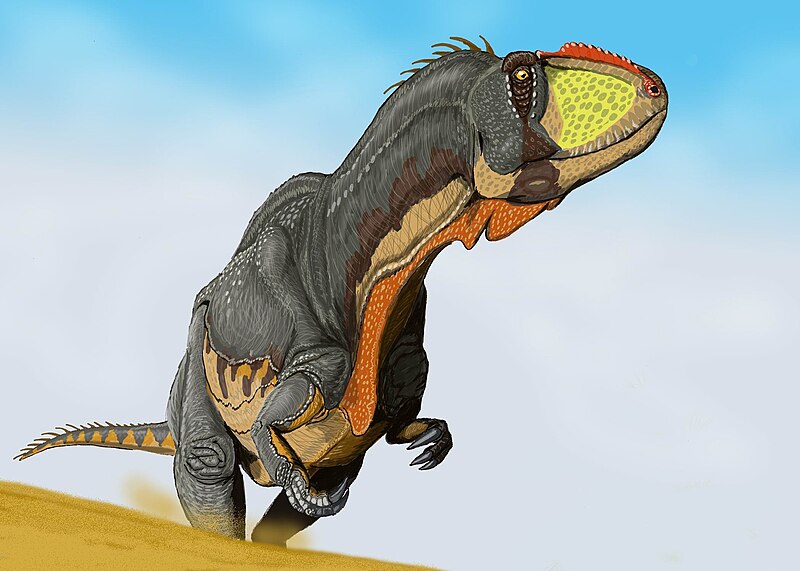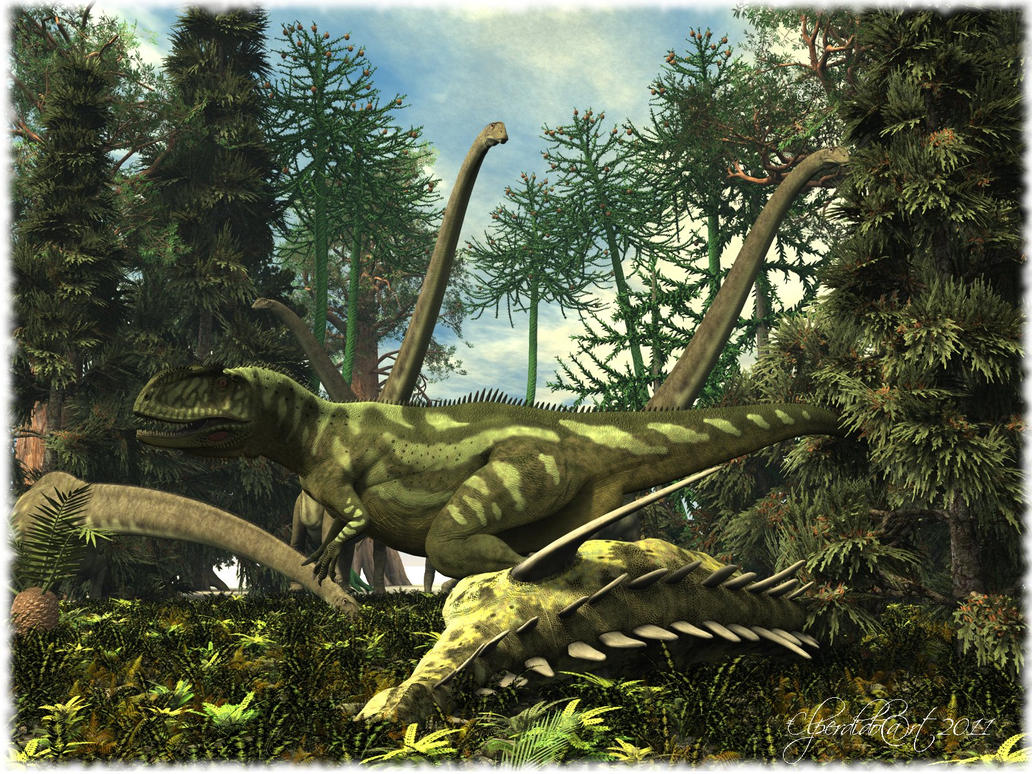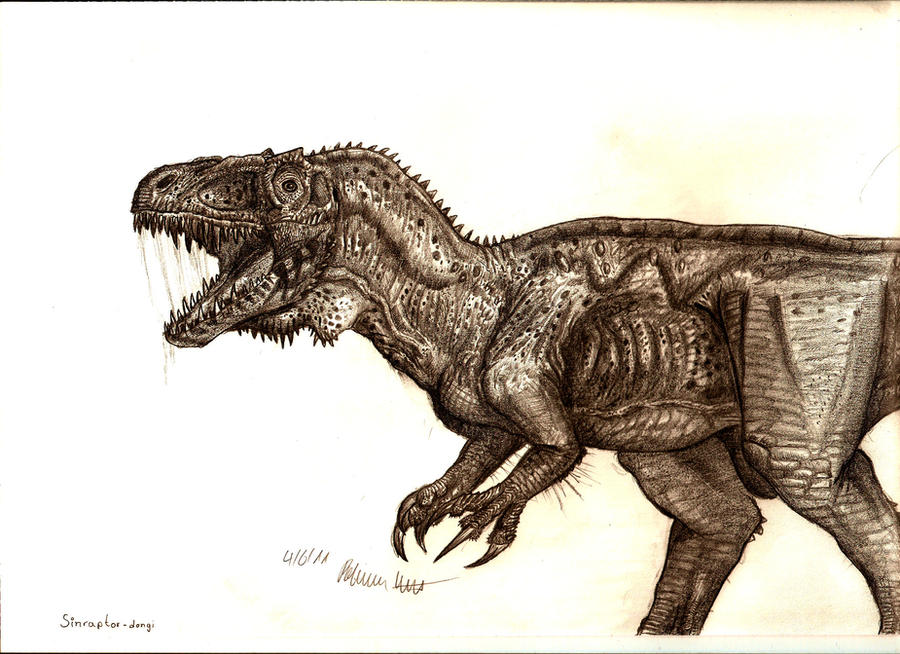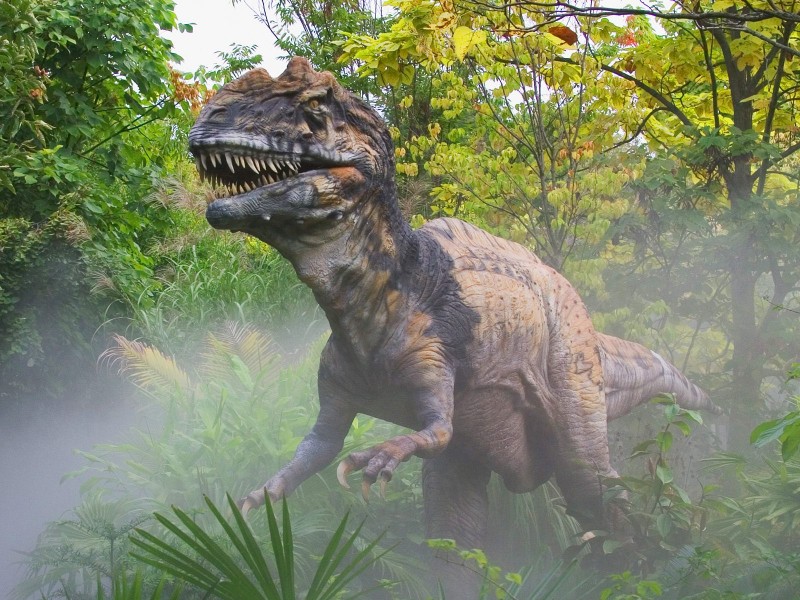[Recent Entries][Archive][Friends][User Info]
Below are the 4 most recent journal entries recorded in the "Сообщество, посвящённое ра" journal:| January 25th, 2013 | |
|---|---|
| 12:55 pm [industrialterro] [Link] |
Yangchuanosaurus Янгчуанозавр (Yangchuanosaurus) — крупный хищный динозавр позднеюрской эпохи, живший около 161-151 миллионов лет назад. Родственник аллозавра, принадлежит к эндемичному семейству восточноазиатских аллозавроидов Sinraptoridae. Самый крупный хищный динозавр из китайских юрских отложений. Происходит из оксфордских слоев формации Shangshaximiao в Сычуане. Отличается высоким коротким черепом, с парой гребней над носовыми костями. Остистые отростки спинных позвонков высокие, образуют небольшой «парус» (вероятно, как приспособление для крепления сильных мышц). Известен по двум относительно полным скелетам разного размера. Меньший скелет (животное длиной около 8 метров, череп длиной 78 см) принадлежит, вероятно, невзрослой особи. Этот скелет стал голотипом типового вида (Y. shangyouensis), описанного в 1978 году группой китайских палеонтологов. Название рода дано в честь известного китайского палеонтолога Янг Чуана (Ян Чунзяна). Второй скелет, принадлежавший особи до 11 метров в длину (череп 1,1 метра в длину, вес мог достигать 3 тонн), описан в 1983 году как второй вид — Yangchuanosaurus magnus. Сейчас обычно оба экземпляра объединяют в один вид. Янгчуанозавр — охотник за крупными завроподами, такими как маменчизавр. По своему образу жизни он был схож с североамериканскими аллозаврами. Yangchuanosaurus is an extinct genus of metriacanthosaurid theropod dinosaur that lived in China during the late Oxfordian (and possibly Kimmeridgian) stage of the Late Jurassic, and was similar in size and appearance to its North American contemporary, Allosaurus. It hails from the Upper Shaximiao Formation and was the largest predator in a landscape which included the sauropods Mamenchisaurus and Omeisaurus as well as the Stegosaurs Chialingosaurus, Tuojiangosaurus and Chungkingosaurus. Dong et al. (1978) named Yangchuanosaurus shangyouensis on the basis of CV 00215, a complete skull and skeleton which was collected from the Shangshaximiao Formation, near Yongchuan, Yongchuan District, Sichuan. It dates to the Oxfordian or the early Kimmeridgian stage of the Late Jurassic period, about 161.2-154 million years ago. It was discovered in June 1977 by a construction worker during the construction of the Shangyou Reservoir Dam. A second species from the same locality, Y. magnus, was named by Dong et al. (1983) on the basis of CV 00216, another complete skull and skeleton. A detailed revision of tetanuran phylogeny by Carrano, Benson & Sampson (2012) revealed that both species are cospecific. Dong et al. (1978) and Dong et al. (1983) differentiated these species primarily on the basis of size. In addition, Dong et al. (1983) noted that the maxilla of Y. magnus has an additional fenestra within the antorbital fossa, whereas Y. shangyouensis possessed only a fossa in this location. However, it is considered to be an intraspecific, possibly ontogenetic, variation. Furthermore, the apparent difference in cervical vertebral morphology can be explained by comparing different positions within the column. Hence, the holotypes of the two species of Yangchuanosaurus are effectively identical, and their codings are identical in Carrano et al. (2012) matrix. Gregory S. Paul (1988) regarded this genus as the same as Metriacanthosaurus, but this has not been supported. Carrano et al. (2012) assigned a third specimen to Y. shangyouensis. CV 00214 is represented by a partial postcranial skeleton lacking the skull. It was collected in the Wujiaba Quarry, near Zigong city, Sichuan, from the lower part of the Shangshaximiao Formation. CV 00214 was initially listed by Dong et al. (1978) in a faunal list as a new species of Szechuanosaurus, Szechuanosaurus "yandonensis". There is no description or illustration of it, making S. "yandonensis" a nomen nudum. Later, Dong et al. (1983) described it, and assigned it to Szechuanosaurus campi, a dubious species which is known only from 4 teeth. Carrano et al. (2012) noted that CV 00214 can't be assigned to S. campi because the holotype materials of S. campi (IVPP V.235, V.236, V.238, V.239; teeth) are non-diagnostic and no teeth are preserved in CV 00214. A recent restudy of CV 00214 by Daniel Chure (2001) concluded that it represented a new taxon, informally named "Szechuanoraptor dongi", into which Szechuanosaurus zigongensis should also be subsumed. However, the most recent revision (by Carrano et al. (2012)) suggested that CV 00214 and "S." zigongensis can't be cospesific as there are no autapomorphies shared between them, and the latter derives from the underlying Xiashaximiao Formation. A phylogenetic analysis found CV 00214 to be most closely related to Y. shangyouensis, and thus the former is assignable to it. Furthermore, Szechuanosaurus zigongensis was found to be closely related to Y. shangyouensis and therefore was designated as the second species of Yangchuanosaurus. Yangchuanosaurus zigongensis is known from four specimens including ZDM 9011 (holotype), a partial postcranial skeleton; ZDM 9012, a left maxilla; ZDM 9013, two teeth and ZDM 9014, a right hind limb. It was first described by Gao (1993), and all specimens were colleted from the Middle Jurassic Xiashaximiao Formation in the Dashanpu Dinosaur Quarry of Zigong, Sichuan. A phylogenetic analysis by Carrano et al. (2012) found Yangchuanosaurus to be the basalmost known metriacanthosaurid and the only non-metriacanthosaurine metriacanthosaurid.
Репродукции (1, 2, 3, 4, 5, 6, 7, 8, 9, 10):
( Read More ) Размеры тела в сравнении с человеком:
Ископаемые останки и реплики (1, 2, 3, 4, 5, 6, 7, 8):
( Read More ) Tags: Вымершие рептилии, Юра, авеметатарзалии, архозавроморфы, архозавры, диапсиды, динозавроморфы, динозавры, карнозавры, синрапториды, тероподы, ящеротазовые |
| January 4th, 2013 | |
| 03:49 pm [industrialterro] [Link] |
Sinraptor Sinraptor is a genus of theropod dinosaur from the Late Jurassic. The name Sinraptor comes from the Latin prefix "Sino", meaning Chinese, and "Raptor" meaning thief. The specific name dongi honours Dong Zhiming. Despite its name, Sinraptor is not related to dromaeosaurids (often nicknamed "raptors") like Velociraptor. The holotype specimen of Sinraptor was uncovered from the Shishugou Formation during a joint Chinese/Canadian expedition to the northwestern Chinese desert in 1987, and described by Philip J. Currie and Xian Zhao in 1994. Standing nearly 3 meters tall (10 ft) and measuring roughly 7.6 meters (25 ft) in length, two species of Sinraptor have been named. S. dongi, the type species, was described by Currie and Zhao in 1994. A second species, originally named Yangchuanosaurus hepingensis by Gao in 1992, may actually represent a second species of Sinraptor. Whether or not this is the case, Sinraptor and Yangchuanosaurus were close relatives, and are classified together in the family Metriacanthosauridae. The skeleton of Sinraptor hepingensis (formerly referred to Yangchuanosaurus) is on display at the Zigong Dinosaur Museum, Zigong, China. Sinraptor dongi skull specimen IVPP 10600 exhibits "a variety of gently curving tooth drags or gouges, shallow, circular punctures and one fully penetrating lesion." One rib was broken and healed via telescoping of its capitular shaft.
Размеры тела в сравнении с человеком:
Ископаемые останки и реплики (1, 2, 3, 4, 5):
Tags: Вымершие рептилии, Юра, авеметатарзалии, архозавроморфы, архозавры, диапсиды, динозавроморфы, динозавры, карнозавры, синрапториды, тероподы, ящеротазовые |
| November 11th, 2012 | |
| 06:12 pm [industrialterro] [Link] |
Poekilopleuron Poekilopleuron (meaning 'varied ribs') is an extinct genus of large basal tetanuran theropod dinosaur, perhaps belonging to the clade Allosauroidea. It measured 9 metres (30 feet) long and 1 ton (1 tonne) in mass. It dates from the Bathonian (Middle Jurassic), 168 to 165 million years ago. Poekilopleuron is known from a partial skeleton discovered by Jacques Amand Eudes-Deslongchamps in July 1835 near La Maladrerie in Normandy, France, in a layer of the Calcaire de Caen Formation. This skeleton, part of the collection of the Musée de la Facultée des Sciences de Caen, was in 1944 destroyed during the Battle of Caen in World War II, and the taxon has since had to be studied on the basis of cast replicas. One set is present in the Muséum National d'Histoire Naturelle in Paris with inventory number MNHN 1897-2, a second in the Yale Peabody Museum, YPM 4938. The remains consisted of caudal vertebrae, cervical ribs, ribs, gastralia or belly ribs, a forelimb and a hindlimb. Eudes-Deslongchamps named the type species Poekilopleuron bucklandii in 1837 or 1838. The generic name is derived from Greek poikilos, "varied", and pleuron, "rib", a reference to the three types of rib present. The specific name, honouring William Buckland, was deliberately identical to that of Megalosaurus bucklandii. Eudes-Deslongchamps thought the specimen might well be proven to belong to this earlier named species; if so, merely the generic name would have to be changed. Indeed, following 1879 Poekilopleuron was often subsumed under Megalosaurus bucklandii. Eudes-Deslongchamps' choice caused problems however, when Friedrich von Huene in 1923 concluded it was part of Megalosaurus but as a separate species within that genus. As both species carried the same epithet bucklandii, they could no longer be distinguished. Von Huene therefore renamed the species into Megalosaurus poekilopleuron. Most later authors continued using the generic name Poekilopleuron. Another problem was caused by the fact that the name was only partially Latinised. In correct Greek it would have been "poikilopleuron", in Latin "poecilopleurum". This induced later writers to improve the spelling, leading to such variants as Poecilopleuron and Poikilopleuron (still used as late as 2006). However, the original name has priority and is valid. Five other species would be named in the genus. In 1869 Edward Drinker Cope renamed Laelaps gallicus into Poekilopleuron gallicum. In 1870 Joseph Leidy created a Poicilopleuron valens based on a fossil probably belonging to Allosaurus. In 1876 Richard Owen named a Poikilopleuron pusillus, in 1879 renamed by Cope to Poekilopleuron minor; in 1887 Harry Govier Seeley made it a separate genus: Aristosuchus. In 1883 W.A. Kiprijanow created a Poekilopleuron schmidti, of which the specific name honours Friedrich Schmidt, based on some indeterminate ribs and a sauropod metatarsal. This chimaera is a nomen dubium. A much later named species is Poekilopleuron valesdunensis created by Ronan Allain in 2002. In 2005 it was renamed Dubreuillosaurus. The most distinctive feature of Poekilopleuron were its forelimbs. Their length, about 60 cm, was a sign of this theropod's more original build. Unlike later Theropoda, whose forelimbs tended toward reduction in length in proportion to the animals' size, Poekilopleuron's were long and, by implication, potent. The length mostly resided in the elongated but powerfully muscled humerus. The antebrachia (forearms) were markedly short and robust, a characteristic shared with Poekilopleuron's slightly later and considerably larger American cousin Torvosaurus. A unique feature is a lack of the olecranon process on the ulna. The fossil of Poekilopleuron showed a rare complete set of gastralia: fourteen pair of belly ribs supported the body of the animal. Because the original fossil was destroyed and no other remains of Poekilopleuron have since been found, and also because of its name change, there is much controversy surrounding its classification that cannot be resolved. Traditionally it has been assigned to the Megalosauridae, but some recent analyses showed a position in the Sinraptoridae; others had as result it was a member of Megalosauroidea, in a basal position or in the Eustreptospondylinae. Benson et al. (2010) found it and Lourinhanosaurus to belong to Sinraptoridae. The material of Poekilopleuron bucklandii includes two tail vertebrae with the chevron of one vertebra ankylosed to the centrum of the next within the development of an exostosis. Two phalanges also preserve pathologies. One probable pedal phalanx shows three low, irregular exostosis-like projections. A second probable manual phalanx exhibits a "low rounded projection resembling a callus." Ralph Molnar considered the occurrence of three pathologies in one individual to be "noteworthy". Sadly the specimens cannot be examined further to determine the etiology of the pathologies because of their destruction during the British bombing raid in 1944.
Размеры тела в сравнении с человеком:
Tags: Вымершие рептилии, Юра, авеметатарзалии, архозавроморфы, архозавры, диапсиды, динозавроморфы, динозавры, карнозавры, синрапториды, тероподы, ящеротазовые |
| November 7th, 2012 | |
| 05:16 pm [industrialterro] [Link] |
Metriacanthosaurus Метриакантозавр (Metriacanthosaurus — «ящер с поднятыми отростками») — род плотоядных тероподов юрского периода. В роде известен один вид — Metriacanthosaurus parkeri. Обитал на территории современной Англии. Длина скелета ~8 метров, ящер весил примерно 1 тонну. Жил 160—154 млн. лет назад. Метриакантозавр был ошибочно классифицирован как мегалозавр, когда не все останки первого были найдены в 1923 году. До сих пор многое остаётся неизвестным об этом динозавре, за исключением того, что короткие шипы выступающие из позвоночника динозавра могли поддерживать небольшой горб. Существует мнение, что метриакантозавр имел более сильную родственную связь с родом шипастых динозавров — спинозавров. Metriacanthosaurus (meaning "moderately-spined lizard") is a genus of sinraptorid dinosaur from the upper Oxford Clay of England, dating to the mid-Jurassic Period, about 160 million years ago (lower Oxfordian). In 1923, German paleontologist Friedrich von Huene wrote a paper on Jurassic and Cretaceous European carnivorous dinosaurs. In this paper, he examined a specimen, OUM J.12144, including an incomplete hip, a leg bone, and part of a backbone, and believed it was a new species of Megalosaurus: Megalosaurus parkeri. The specific name honours W. Parker who in the nineteenth century had collected the fossils near Jordan's Cliff at Weymouth. In 1932, however, von Huene concluded it was species of Altispinax, A. parkeri. In 1964, scientist Alick Walker decided these fossils were too different from Altispinax, as it lacked the long vertebral spines, and named a new genus, Metriacanthosaurus. The generic name is derived from Greek metrikos, "moderate", and akantha, "spine". Metriacanthosaurus thus gets its name from its vertebrae, which are taller than typical carnosaurs, like Allosaurus, but lower than other high-spined dinosaurs like Acrocanthosaurus. Metriacanthosaurus was a medium-sized theropod with a femur length of eighty centimetres. Gregory S. Paul in 1988 estimated its weight at a tonne. Originally assigned by Walker to the Megalosauridae, Metriacanthosaurus has since been found to form a family with Yangchuanosaurus and other close relatives, named Metriacanthosauridae in 1988. Contrary to ICZN rules for naming animal groups, this family has been referred to mainly by the junior synonym Sinraptoridae. Синрапториды (Sinraptoridae) — семейство хищных и, как правило, крупных теропод (Theropoda). Многие из них изначально включались в семейства Megalosauridae или Allosauridae. В соответствии с филогенетической классификацией 2005 года представляют собой монофилетическую группу, которая содержит род Sinraptor и все виды, которые связаны с ним больше, чем кархародонтозавриды (Carcharodontosauridae) или аллозавриды (Allosauridae).
Репродукции (1, 2, 3, 4, 5, 6, 7, 8):
( Read More ) Размеры тела в сравнении с человеком:
Tags: Вымершие рептилии, Юра, авеметатарзалии, архозавроморфы, архозавры, диапсиды, динозавроморфы, динозавры, карнозавры, синрапториды, тероподы, ящеротазовые |






























